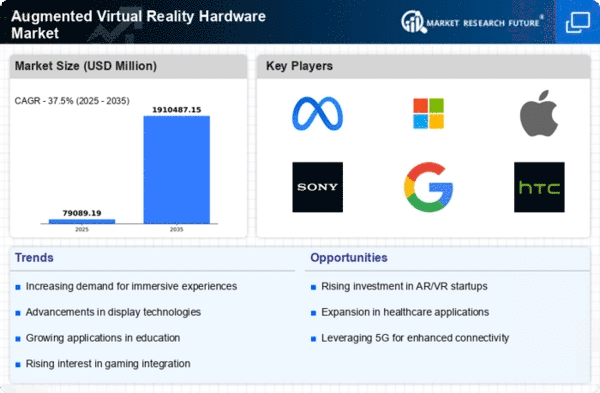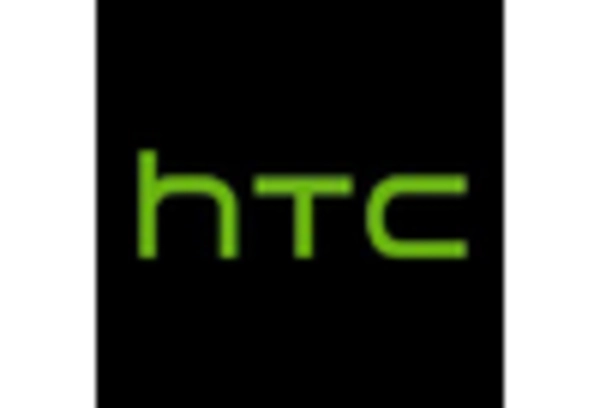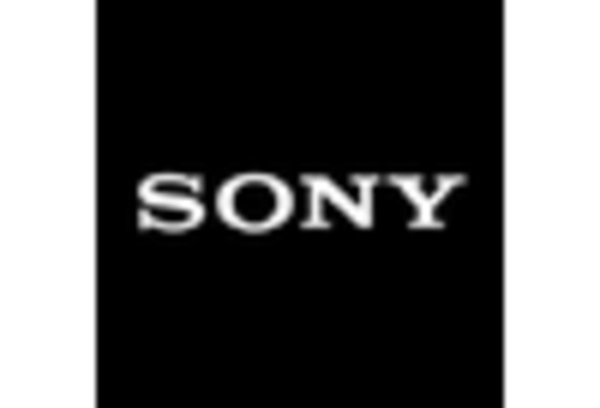-
Executive Summary 19
-
MARKET ATTRACTIVENESS
-
ANALYSIS 20
-
Market Introduction 21
-
Definition 21
-
Scope
-
of the Study 21
-
Research Objective 21
-
Market Structure 22
-
Research Methodology 23
-
Market Dynamics 30
-
INTRODUCTION 30
- Consumer and Commercial Rising Interest 31
- Evolution
- DRIVERS IMPACT ANALYSIS 32
-
drivers 31
-
of Silicon Technologies 31
-
restraints
- Limited Processing Power, Storage and Memory in Mobile Phones 32
-
Opportunities 33
- Growing Use of Smartphones and Tablets for AR&
- Rising Usage of VR Beyond Gaming 33
-
VR 33
-
Impact Analysis of
- Impact on Semiconductor Manufacturers 34
- Impact
- Impact on Device Manufacturers 35
-
COVID-19 34
-
on ComponentManufacturers 34
-
COVID-19 Impact on Supply Chain 35
-
MARKET FACTOR ANALYSIS 36
-
Supply
- hardware/components manufacturers 36
- Technology
- End-Users 37
-
Chain Analysis 36
-
Integrators 36
-
Porter’s Five Forces Model
- Threat of New Entrants 38
- Bargaining Power of Suppliers
- Threat of Substitutes 38
- Bargaining Power of Buyers 38
- Intensity of Rivalry 38
-
GLOBAL Augmented Reality and Virtual Reality
-
Hardware MARKET,
-
BY Hardware Type 39
-
OVERVIEW 39
- Global
-
Augmented Reality and Virtual Reality Hardware market, BY Hardware Type,
-
(USD MILLION) 40
-
Sensors 40
-
Processors 40
-
Controllers
-
Cameras 40
-
Headphones 41
-
Display Monitors 41
-
Others 41
-
GLOBAL Augmented Reality and Virtual Reality Hardware MARKET,
-
BY Application 42
-
OVERVIEW 42
- Global Augmented Reality and
-
Virtual Reality Hardware market, BY Application,
-
Head Mounted Display 43
-
Head Up Display 43
-
Handheld
-
Devices 43
-
GLOBAL Augmented Reality and Virtual Reality Hardware MARKET,
-
BY Industry Vertical 44
-
OVERVIEW 44
- Global Augmented Reality
-
and Virtual Reality Hardware market, BY Industry Vertical,
-
(USD MILLION) 45
-
Aerospace & Defense 45
-
Gaming & Entertainment
-
Education & Training 46
-
Healthcare 46
-
Automotive
-
Others 46
-
Global Augmented Reality and Virtual Reality Hardware
-
MARKET,
-
BY Region 47
-
OVERVIEW 47
- Global Augmented Reality
-
and Virtual Reality Hardware market, by Region, 2021 VS 2030
-
(USD MILLION)
-
(USD MILLION) 48
-
Global Augmented Reality and Virtual Reality Hardware market, BY Region,
-
North america 49
- North
-
america: Augmented Reality and Virtual Reality Hardware market, BY Country,
-
North America Augmented Reality and
-
Virtual Reality Hardware market, BY Hardware Type,
-
BY Application,
-
North America AUGMENTED REALITY AND VIRTUAL REALITY HARDWARE market,
-
North America
-
AUGMENTED REALITY AND VIRTUAL REALITY HARDWARE market, BY Industry
-
Vertical,
-
US 54
-
US AUGMENTED REALITY
-
AND VIRTUAL REALITY HARDWARE market, BY Hardware Type,
-
MILLION) 54
-
BY Application, 2018–2030
-
(USD MILLION) 54
-
US AUGMENTED REALITY AND VIRTUAL REALITY HARDWARE market,
-
US AUGMENTED
-
REALITY AND VIRTUAL REALITY HARDWARE market, BY Industry Vertical,
-
(USD MILLION) 55
-
CANADA 55
-
CANADA AUGMENTED REALITY AND
-
VIRTUAL REALITY HARDWARE market, BY Hardware Type,
-
Application,
-
CANADA AUGMENTED REALITY AND VIRTUAL REALITY HARDWARE market, BY
-
CANADA AUGMENTED
-
REALITY AND VIRTUAL REALITY HARDWARE market, BY Industry Vertical,
-
(USD MILLION) 56
-
Europe 57
- Europe: Augmented Reality and Virtual
-
Reality Hardware market, BY Country, 2018–2030
-
(USD MILLION) 58
-
Europe Augmented Reality and Virtual Reality Hardware market, BY Hardware Type,
-
Europe AUGMENTED REALITY AND VIRTUAL
-
REALITY HARDWARE market, BY Application, 2018–2030
-
(USD MILLION) 60
-
Vertical,
-
Europe AUGMENTED REALITY AND VIRTUAL REALITY HARDWARE market, BY Industry
-
UK 62
-
UK
-
AUGMENTED REALITY AND VIRTUAL REALITY HARDWARE market, BY Hardware Type, 2018–2030
-
(USD MILLION) 62
-
UK AUGMENTED REALITY AND VIRTUAL REALITY HARDWARE
-
market, BY Application, 2018–2030
-
(USD MILLION) 62
-
UK AUGMENTED
-
REALITY AND VIRTUAL REALITY HARDWARE market, BY Industry Vertical,
-
(USD MILLION) 63
-
GERMANY 63
-
GERMANY AUGMENTED REALITY AND
-
VIRTUAL REALITY HARDWARE market, BY Hardware Type,
-
Application,
-
GERMANY AUGMENTED REALITY AND VIRTUAL REALITY HARDWARE market, BY
-
GERMANY AUGMENTED
-
REALITY AND VIRTUAL REALITY HARDWARE market, BY Industry Vertical,
-
(USD MILLION) 64
-
FRANCE 65
-
FRANCE AUGMENTED REALITY AND
-
VIRTUAL REALITY HARDWARE market, BY Hardware Type,
-
Application,
-
FRANCE AUGMENTED REALITY AND VIRTUAL REALITY HARDWARE market, BY
-
FRANCE AUGMENTED
-
REALITY AND VIRTUAL REALITY HARDWARE market, BY Industry Vertical,
-
(USD MILLION) 66
-
ITALY 66
-
ITALY AUGMENTED REALITY AND VIRTUAL
-
REALITY HARDWARE market, BY Hardware Type,
-
ITALY AUGMENTED REALITY AND VIRTUAL REALITY HARDWARE market, BY Application,
-
ITALY AUGMENTED REALITY AND
-
VIRTUAL REALITY HARDWARE market, BY Industry Vertical,
-
MILLION) 67
-
REST OF EUROPE 68
-
REST OF EUROPE AUGMENTED REALITY
-
AND VIRTUAL REALITY HARDWARE market, BY Hardware
-
Type, 2018–2030 (USD
-
MILLION) 68
-
market,
-
BY Application, 2018–2030 (USD MILLION) 68
-
REST OF EUROPE AUGMENTED REALITY AND VIRTUAL REALITY HARDWARE
-
REST
-
OF EUROPE AUGMENTED REALITY AND VIRTUAL REALITY HARDWARE market, BY Industry
-
Vertical, 2018–2030 (USD MILLION) 69
-
Asia-Pacific 70
-
Asia-Pacific: Augmented Reality and Virtual Reality Hardware market, BY Country,
-
Asia-Pacific Augmented Reality
-
and Virtual Reality Hardware market, BY Hardware Type,
-
MILLION) 72
-
Asia-Pacific AUGMENTED REALITY AND VIRTUAL REALITY HARDWARE
-
market, BY Application,
-
Asia-Pacific
-
AUGMENTED REALITY AND VIRTUAL REALITY HARDWARE market, BY Industry Vertical,
-
CHINA 75
-
CHINA AUGMENTED
-
REALITY AND VIRTUAL REALITY HARDWARE market, BY Hardware Type,
-
(USD MILLION) 75
-
CHINA AUGMENTED REALITY AND VIRTUAL REALITY HARDWARE
-
market, BY Application,
-
CHINA
-
AUGMENTED REALITY AND VIRTUAL REALITY HARDWARE market, BY Industry Vertical,
-
JAPAN 76
-
JAPAN AUGMENTED
-
REALITY AND VIRTUAL REALITY HARDWARE market, BY Hardware Type,
-
(USD MILLION) 76
-
JAPAN AUGMENTED REALITY AND VIRTUAL REALITY HARDWARE
-
market, BY Application,
-
JAPAN
-
AUGMENTED REALITY AND VIRTUAL REALITY HARDWARE market, BY Industry Vertical,
-
INDIA 78
-
INDIA AUGMENTED
-
REALITY AND VIRTUAL REALITY HARDWARE market, BY Hardware Type,
-
(USD MILLION) 78
-
INDIA AUGMENTED REALITY AND VIRTUAL REALITY HARDWARE
-
market, BY Application, 2018–2030
-
(USD MILLION) 78
-
INDIA
-
AUGMENTED REALITY AND VIRTUAL REALITY HARDWARE market, BY Industry Vertical,
-
SOUTH KOREA 79
-
SOUTH
-
KOREA AUGMENTED REALITY AND VIRTUAL REALITY HARDWARE market, BY Hardware
-
Type,
-
SOUTH KOREA AUGMENTED REALITY AND
-
VIRTUAL REALITY HARDWARE market, BY Application,
-
BY Industry
-
Vertical, 2018–2030 (USD MILLION) 80
-
ASIA-PACIFIC 81
-
REALITY HARDWARE market,
-
BY Hardware Type, 2018–2030 (USD MILLION) 81
-
BY Application, 2018–2030 (USD MILLION) 81
-
AUGMENTED REALITY AND VIRTUAL REALITY HARDWARE market,
-
BY Industry Vertical,
-
Middle East & AfricaAugmented Reality and Virtual Reality Hardware market,
-
BY Hardware Type, 2018–2030 (USD MILLION) 83
-
AfricaAUGMENTED REALITY AND VIRTUAL REALITY HARDWARE market,
-
BY Application,
-
AND VIRTUAL REALITY HARDWARE market,
-
BY Industry Vertical, 2018–2030
-
(USD MILLION) 85
-
SOUTH KOREA AUGMENTED REALITY AND VIRTUAL REALITY HARDWARE market,
-
REST OF
-
REST OF ASIA-PACIFIC AUGMENTED REALITY AND VIRTUAL
-
REST OF ASIA-PACIFIC AUGMENTED REALITY AND VIRTUAL REALITY HARDWARE market,
-
REST OF ASIA-PACIFIC
-
Middle East & Africa 82
- Middle East &
- Middle East & AfricaAUGMENTED REALITY
-
Latin America 86
- Latin AmericaAugmented Reality
-
and Virtual Reality Hardware market, BY Hardware
-
Type, 2018–2030 (USD
-
MILLION) 87
-
Latin AmericaAUGMENTED REALITY AND VIRTUAL REALITY HARDWARE
-
market, BY Application,
-
Latin
-
AmericaAUGMENTED REALITY AND VIRTUAL REALITY HARDWARE market, BY Industry
-
Vertical,
-
COMPETITIVE LANDSCAPE 90
-
Competitive
-
benchmarking 91
-
Vendor share analysis 92
-
recent developments
- Partnerships/Agreements/contracts/Collaborations 92
- Business
- Product Launches/developments 93
-
Expansions/AcquisItions 93
-
Company Profiles 95
-
oculus vr (meta) 95
- COMPANY OVERVIEW 95
- FINANCIAL OVERVIEW 96
- Products/Solutions/Services OFFERed 96
- KEY DEVELOPMENTS 97
- SWOT ANALYSIS 97
- KEY STRATEGIES
-
samsung electronics co., ltd 98
- COMPANY OVERVIEW 98
- FINANCIAL OVERVIEW 99
- Products/Solutions/Services Offered 99
- KEY DEVELOPMENTS 100
- SWOT ANALYSIS 100
- KEY STRATEGIES
-
-
WORLDVIZ 101
- COMPANY OVERVIEW 101
- Products/Solutions/Services Offered 101
-
FINANCIAL OVERVIEW 101
-
KEY DEVELOPMENTS 101
-
nxp semiconductor n.v 102
- COMPANY OVERVIEW
- FINANCIAL OVERVIEW 103
- Products/Solutions/Services Offered
- KEY DEVELOPMENTS 104
- SWOT ANALYSIS 104
- KEY
-
STRATEGIES 104
-
bosch sensortec gmbh (bosch group) 105
- COMPANY
- FINANCIAL OVERVIEW 106
- Products/Solutions/Services
- KEY DEVELOPMENTS 107
- SWOT ANALYSIS 107
-
OVERVIEW 105
-
Offered 106
-
KEY STRATEGIES 108
-
inertial labs 109
- COMPANY OVERVIEW 109
- FINANCIAL OVERVIEW 109
- Products/Solutions/Services OFFERed
- KEY DEVELOPMENTS 109
-
sony corporation 110
- FINANCIAL OVERVIEW 111
- Products/Solutions/Services
- KEY DEVELOPMENTS 112
- SWOT ANALYSIS 112
-
COMPANY OVERVIEW 110
-
OFFERed 112
-
KEY STRATEGIES 113
-
valve corporation 114
- COMPANY OVERVIEW
- FINANCIAL OVERVIEW 114
- Products/Solutions/Services OFFERed
- KEY DEVELOPMENTS 114
-
-
htc corproation 115
- COMPANY OVERVIEW 115
- FINANCIAL OVERVIEW 115
- Products/Solutions/Services
- KEY DEVELOPMENTS 116
- SWOT ANALYSIS 117
-
OFFERed 116
-
KEY STRATEGIES 117
-
tcl technology 118
- COMPANY OVERVIEW 118
- FINANCIAL OVERVIEW 119
- Products/Solutions/Services OFFERed
- KEY DEVELOPMENTS 120
- SWOT ANALYSIS 120
-
KEY STRATEGIES 120
-
dpvr. 121
- COMPANY OVERVIEW 121
- Products/Solutions/Services OFFERed 121
-
FINANCIAL OVERVIEW 121
-
KEY DEVELOPMENTS 121
-
VUZIX 122
- COMPANY OVERVIEW 122
- Products/Solutions/Services OFFERed 123
- SWOT ANALYSIS 124
- KEY STRATEGIES
-
FINANCIAL OVERVIEW 123
-
KEY DEVELOPMENTS 124
-
qualcomm technologies inc. 125
- COMPANY OVERVIEW 125
- FINANCIAL OVERVIEW 126
- Products/Solutions/Services OFFERed
- KEY DEVELOPMENTS 127
- SWOT ANALYSIS 127
-
KEY STRATEGIES 127
-
-
sieko epson corporation 128
- FINANCIAL OVERVIEW 128
- Products/Solutions/Services
- KEY DEVELOPMENTS 129
- SWOT ANALYSIS 129
- KEY STRATEGIES 130
-
COMPANY OVERVIEW 128
-
OFFERed 129
-
penumbra, inc. 131
- COMPANY
- FINANCIAL OVERVIEW 131
- Products/Solutions/Services
- KEY DEVELOPMENTS 132
- SWOT ANALYSIS 132
- KEY STRATEGIES 133
-
OVERVIEW 131
-
OFFERed 132
-
Arm Limited 134
- COMPANY OVERVIEW
- FINANCIAL OVERVIEW 134
- Products/Solutions/Services
- KEY DEVELOPMENTS 134
-
OFFERed 134
-
LEKE VR 135
- FINANCIAL OVERVIEW 135
- Products/Solutions/Services
- KEY DEVELOPMENTS 135
-
COMPANY OVERVIEW 135
-
OFFERed 135
-
google llc 136
- FINANCIAL OVERVIEW 137
- Products/Solutions/Services
- KEY DEVELOPMENTS 138
- SWOT ANALYSIS 138
- KEY STRATEGIES 138
-
COMPANY OVERVIEW 136
-
OFFERed 137
-
-
LIST OF TABLES
-
MARKET
-
SYNOPSIS 20
-
GLOBAL AUGMENTED REALITY AND VIRTUAL REALITY HARDWARE MARKET,
-
BY HARDWARE TYPE, 2018–2030 (USD MILLION) 40
-
GLOBAL AUGMENTED
-
REALITY AND VIRTUAL REALITY HARDWARE MARKET, BY APPLICATION, 2018–2030 (USD
-
MILLION) 43
-
GLOBAL AUGMENTED REALITY AND VIRTUAL REALITY HARDWARE MARKET,
-
BY INDUSTRY VERTICAL, 2018–2030
-
(USD MILLION) 45
-
GLOBAL
-
AUGMENTED REALITY AND VIRTUAL REALITY HARDWARE MARKET, BY REGION, 2018–2030
-
(USD MILLION) 48
-
NORTH AMERICA AUGMENTED REALITY AND VIRTUAL REALITY
-
HARDWARE MARKET, BY COUNTRY, 2018–2030
-
(USD MILLION) 50
-
TABLE 7
-
NORTH AMERICA AUGMENTED REALITY AND VIRTUAL REALITY HARDWARE MARKET, BY HARDWARE
-
TYPE, 2018–2030
-
(USD MILLION) 51
-
NORTH AMERICA AUGMENTED
-
REALITY AND VIRTUAL REALITY HARDWARE MARKET, BY APPLICATION, 2019–2030
-
(USD MILLION) 52
-
NORTH AMERICA AUGMENTED REALITY AND VIRTUAL REALITY
-
HARDWARE MARKET, BY INDUSTRY VERTICAL, 2018–2030
-
(USD MILLION) 53
-
US AUGMENTED REALITY AND VIRTUAL REALITY HARDWARE MARKET, BY HARDWARE
-
TYPE, 2018–2030 (USD MILLION) 54
-
US AUGMENTED REALITY AND VIRTUAL
-
REALITY HARDWARE MARKET, BY APPLICATION, 2018–2030 (USD MILLION) 54
-
TABLE
-
US AUGMENTED REALITY AND VIRTUAL REALITY HARDWARE MARKET, BY INDUSTRY VERTICAL,
-
CANADA AUGMENTED REALITY AND VIRTUAL
-
REALITY HARDWARE MARKET, BY HARDWARE TYPE, 2018–2030
-
(USD MILLION) 55
-
CANADA AUGMENTED REALITY AND VIRTUAL REALITY HARDWARE MARKET, BY APPLICATION,
-
CANADA AUGMENTED REALITY AND VIRTUAL
-
REALITY HARDWARE MARKET, BY INDUSTRY VERTICAL, 2018–2030
-
(USD MILLION)
-
EUROPE AUGMENTED REALITY AND VIRTUAL REALITY HARDWARE MARKET, BY
-
COUNTRY, 2018–2030 (USD MILLION) 58
-
EUROPE AUGMENTED REALITY
-
AND VIRTUAL REALITY HARDWARE MARKET, BY HARDWARE TYPE, 2018–2030 (USD MILLION)
-
EUROPE AUGMENTED REALITY AND VIRTUAL REALITY HARDWARE MARKET, BY
-
APPLICATION, 2019–2030 (USD MILLION) 60
-
EUROPE AUGMENTED REALITY
-
AND VIRTUAL REALITY HARDWARE MARKET, BY INDUSTRY VERTICAL, 2018–2030
-
(USD
-
MILLION) 61
-
UK AUGMENTED REALITY AND VIRTUAL REALITY HARDWARE MARKET,
-
BY HARDWARE TYPE, 2018–2030 (USD MILLION) 62
-
UK AUGMENTED REALITY
-
AND VIRTUAL REALITY HARDWARE MARKET, BY APPLICATION, 2018–2030 (USD MILLION)
-
UK AUGMENTED REALITY AND VIRTUAL REALITY HARDWARE MARKET, BY INDUSTRY
-
VERTICAL, 2018–2030 (USD MILLION) 63
-
GERMANY AUGMENTED REALITY
-
AND VIRTUAL REALITY HARDWARE MARKET, BY HARDWARE TYPE, 2018–2030
-
(USD
-
MILLION) 63
-
GERMANY AUGMENTED REALITY AND VIRTUAL REALITY HARDWARE
-
MARKET, BY APPLICATION, 2018–2030 (USD MILLION) 64
-
GERMANY AUGMENTED
-
REALITY AND VIRTUAL REALITY HARDWARE MARKET, BY INDUSTRY VERTICAL, 2018–2030
-
(USD MILLION) 64
-
FRANCE AUGMENTED REALITY AND VIRTUAL REALITY
-
HARDWARE MARKET, BY HARDWARE TYPE, 2018–2030 (USD MILLION) 65
-
TABLE 27
-
FRANCE AUGMENTED REALITY AND VIRTUAL REALITY HARDWARE MARKET, BY APPLICATION, 2018–2030
-
(USD MILLION) 65
-
FRANCE AUGMENTED REALITY AND VIRTUAL REALITY HARDWARE
-
MARKET, BY INDUSTRY VERTICAL, 2018–2030
-
(USD MILLION) 66
-
TABLE
-
ITALY AUGMENTED REALITY AND VIRTUAL REALITY HARDWARE MARKET, BY HARDWARE TYPE,
-
ITALY AUGMENTED REALITY AND VIRTUAL
-
REALITY HARDWARE MARKET, BY APPLICATION, 2018–2030 (USD MILLION) 67
-
TABLE
-
ITALY AUGMENTED REALITY AND VIRTUAL REALITY HARDWARE MARKET, BY INDUSTRY VERTICAL,
-
REST OF EUROPE AUGMENTED REALITY
-
AND VIRTUAL REALITY HARDWARE MARKET, BY HARDWARE TYPE, 2018–2030
-
(USD
-
MILLION) 68
-
REST OF EUROPE AUGMENTED REALITY AND VIRTUAL REALITY HARDWARE
-
MARKET, BY APPLICATION, 2018–2030
-
(USD MILLION) 68
-
REST
-
OF EUROPE AUGMENTED REALITY AND VIRTUAL REALITY HARDWARE MARKET, BY INDUSTRY VERTICAL,
-
(USD MILLION) 69
-
ASIA-PACIFIC AUGMENTED REALITY
-
AND VIRTUAL REALITY HARDWARE MARKET, BY COUNTRY, 2018–2030 (USD MILLION) 71
-
ASIA-PACIFIC AUGMENTED REALITY AND VIRTUAL REALITY HARDWARE MARKET, BY
-
HARDWARE TYPE, 2018–2030
-
(USD MILLION) 72
-
ASIA-PACIFIC
-
AUGMENTED REALITY AND VIRTUAL REALITY HARDWARE MARKET, BY APPLICATION, 2019–2030
-
(USD MILLION) 73
-
ASIA-PACIFIC AUGMENTED REALITY AND VIRTUAL
-
REALITY HARDWARE MARKET, BY INDUSTRY VERTICAL, 2018–2030
-
(USD MILLION)
-
CHINA AUGMENTED REALITY AND VIRTUAL REALITY HARDWARE MARKET, BY
-
HARDWARE TYPE, 2018–2030 (USD MILLION) 75
-
CHINA AUGMENTED REALITY
-
AND VIRTUAL REALITY HARDWARE MARKET, BY APPLICATION, 2018–2030 (USD MILLION)
-
CHINA AUGMENTED REALITY AND VIRTUAL REALITY HARDWARE MARKET, BY
-
INDUSTRY VERTICAL, 2018–2030
-
(USD MILLION) 76
-
JAPAN AUGMENTED
-
REALITY AND VIRTUAL REALITY HARDWARE MARKET, BY HARDWARE TYPE, 2018–2030 (USD
-
MILLION) 76
-
JAPAN AUGMENTED REALITY AND VIRTUAL REALITY HARDWARE MARKET,
-
BY APPLICATION, 2018–2030 (USD MILLION) 77
-
JAPAN AUGMENTED REALITY
-
AND VIRTUAL REALITY HARDWARE MARKET, BY INDUSTRY VERTICAL, 2018–2030
-
(USD
-
MILLION) 77
-
INDIA AUGMENTED REALITY AND VIRTUAL REALITY HARDWARE MARKET,
-
BY HARDWARE TYPE, 2018–2030 (USD MILLION) 78
-
INDIA AUGMENTED
-
REALITY AND VIRTUAL REALITY HARDWARE MARKET, BY APPLICATION, 2018–2030 (USD
-
MILLION) 78
-
INDIA AUGMENTED REALITY AND VIRTUAL REALITY HARDWARE MARKET,
-
BY INDUSTRY VERTICAL, 2018–2030
-
(USD MILLION) 79
-
SOUTH
-
KOREA AUGMENTED REALITY AND VIRTUAL REALITY HARDWARE MARKET, BY HARDWARE TYPE, 2018–2030
-
(USD MILLION) 79
-
SOUTH KOREA AUGMENTED REALITY AND VIRTUAL REALITY
-
HARDWARE MARKET, BY APPLICATION, 2018–2030
-
(USD MILLION) 80
-
TABLE
-
SOUTH KOREA AUGMENTED REALITY AND VIRTUAL REALITY HARDWARE MARKET, BY INDUSTRY
-
VERTICAL, 2018–2030
-
(USD MILLION) 80
-
REST OF ASIA-PACIFIC
-
AUGMENTED REALITY AND VIRTUAL REALITY HARDWARE MARKET, BY HARDWARE TYPE, 2018–2030
-
(USD MILLION) 81
-
REST OF ASIA-PACIFIC AUGMENTED REALITY AND
-
VIRTUAL REALITY HARDWARE MARKET, BY APPLICATION, 2018–2030
-
(USD MILLION)
-
REST OF ASIA-PACIFIC AUGMENTED REALITY AND VIRTUAL REALITY HARDWARE
-
MARKET, BY INDUSTRY VERTICAL,
-
TABLE
-
MIDDLE EAST & AFRICAAUGMENTED REALITY AND VIRTUAL REALITY HARDWARE MARKET,
-
BY HARDWARE TYPE, 2018–2030
-
(USD MILLION) 83
-
MIDDLE EAST
-
& AFRICAAUGMENTED REALITY AND VIRTUAL REALITY HARDWARE MARKET, BY APPLICATION,
-
(USD MILLION) 84
-
MIDDLE EAST & AFRICAAUGMENTED
-
REALITY AND VIRTUAL REALITY HARDWARE MARKET, BY INDUSTRY VERTICAL,
-
(USD MILLION) 85
-
LATIN AMERICAAUGMENTED REALITY AND VIRTUAL REALITY
-
HARDWARE MARKET, BY HARDWARE TYPE, 2018–2030
-
(USD MILLION) 87
-
TABLE
-
LATIN AMERICAAUGMENTED REALITY AND VIRTUAL REALITY HARDWARE MARKET, BY APPLICATION,
-
(USD MILLION) 88
-
LATIN AMERICA AUGMENTED REALITY
-
AND VIRTUAL REALITY HARDWARE MARKET, BY INDUSTRY VERTICAL, 2018–2030
-
(USD
-
MILLION) 89
-
PARTNERSHIPS/AGREEMENTS/CONTRACTS/COLLABORATIONS 92
-
BUSINESS EXPANSIONS/ACQUISITIONS 93
-
PRODUCT LAUNCHES/DEVELOPMENTS
-
OCULUS VR (META): PRODUCTS/SOLUTIONS/SERVICES OFFERED 96
-
TABLE
-
OCULUS VR (META): KEY DEVELOPMENTS 97
-
SAMSUNG ELECTRONICS CO.,
-
LTD: PRODUCTS/SOLUTIONS/SERVICES OFFERED 99
-
SAMSUNG ELECTRONICS CO.,
-
LTD: KEY DEVELOPMENTS 100
-
WORLDVIZ: PRODUCTS/SOLUTIONS/SERVICES OFFERED
-
NXP SEMICONDUCTORS N.V: PRODUCTS/SOLUTIONS/SERVICES OFFERED 103
-
NXP SEMICONDUCTORS N.V: KEY DEVELOPMENTS 104
-
BOSCH SENSORTEC
-
GMBH (BOSCH GROUP): PRODUCTS/SOLUTIONS/SERVICES OFFERED 106
-
BOSCH
-
SENSORTEC GMBH (BOSCH GROUP): KEY DEVELOPMENTS 107
-
INERTIAL LABS:
-
PRODUCTS/SOLUTIONS/SERVICES OFFERED 109
-
INERTIAL LABS: KEY DEVELOPMENTS
-
SONY CORPORATION: PRODUCTS/SOLUTIONS/SERVICES OFFERED 112
-
TABLE
-
SONY CORPORATION: KEY DEVELOPMENTS 112
-
VALVE CORPORATION: PRODUCTS/SOLUTIONS/SERVICES
-
OFFERED 114
-
VALVE CORPORATION: KEY DEVELOPMENTS 114
-
TABLE 78
-
HTC CORPORATION: PRODUCTS/SOLUTIONS/SERVICES OFFERED 116
-
HTC CORPORATION:
-
KEY DEVELOPMENTS 116
-
TCL TECHNOLOGY: PRODUCTS/SOLUTIONS/SERVICES OFFERED
-
TCL TECHNOLOGY: KEY DEVELOPMENTS 120
-
DPVR.: PRODUCTS/SOLUTIONS/SERVICES
-
OFFERED 121
-
VUZIX: PRODUCTS/SOLUTIONS/SERVICES OFFERED 123
-
TABLE
-
VUZIX: KEY DEVELOPMENTS 124
-
QUALCOM TECHNOLOGIES INC.: PRODUCTS/SOLUTIONS/SERVICES
-
OFFERED 126
-
QUALCOM TECHNOLOGIES INC.: KEY DEVELOPMENTS 127
-
TABLE
-
SEIKO EPSON CORPORATION: PRODUCTS/SOLUTIONS/SERVICES OFFERED 129
-
TABLE 88
-
SEIKO EPSON CORPORATION: KEY DEVELOPMENTS 129
-
PENUMBRA, INC: PRODUCTS/SOLUTIONS/SERVICES
-
OFFERED 132
-
PENUMBRA, INC: KEY DEVELOPMENTS 132
-
ARM
-
LIMITED: PRODUCTS/SOLUTIONS/SERVICES OFFERED 134
-
LEKE VR: PRODUCTS/SOLUTIONS/SERVICES
-
OFFERED 135
-
GOOGLE LLC: PRODUCTS/SOLUTIONS/SERVICES OFFERED 137
-
GOOGLE LLC: KEY DEVELOPMENTS 138
-
-
LIST OF FIGURES
-
MARKET ATTRACTIVENESS ANALYSIS: GLOBAL AUGMENTED REALITY AND VIRTUAL
-
REALITY HARDWARE MARKET 20
-
GLOBAL AUGMENTED REALITY AND VIRTUAL REALITY
-
HARDWARE MARKET: MARKET STRUCTURE 22
-
BOTTOM-UP AND TOP-DOWN APPROACHES
-
MARKET DYNAMICS: ANALYSIS OF THE GLOBAL AUGMENTED REALITY AND VIRTUAL
-
REALITY HARDWARE MARKET 30
-
DRIVERS IMPACT ANALYSIS: GLOBAL AUGMENTED
-
REALITY AND VIRTUAL REALITY HARDWARE MARKET 32
-
RESTRAINTS IMPACT ANALYSIS:
-
GLOBAL AUGMENTED REALITY AND VIRTUAL REALITY HARDWARE MARKET 33
-
SUPPLY
-
CHAIN ANALYSIS: GLOBAL AUGMENTED REALITY AND VIRTUAL REALITY HARDWARE MARKET 36
-
PORTER'S FIVE FORCES ANALYSIS: GLOBAL AUGMENTED REALITY AND VIRTUAL REALITY
-
HARDWARE MARKET 37
-
GLOBAL AUGMENTED REALITY AND VIRTUAL REALITY HARDWARE
-
MARKET, BY HARDWARE TYPE, 2021 (% SHARE) 39
-
GLOBAL AUGMENTED REALITY
-
AND VIRTUAL REALITY HARDWARE MARKET, BY HARDWARE TYPE, 2021 VS 2030
-
(USD MILLION)
-
GLOBAL AUGMENTED REALITY AND VIRTUAL REALITY HARDWARE MARKET,
-
BY APPLICATION, 2021 (% SHARE) 42
-
GLOBAL AUGMENTED REALITY AND VIRTUAL
-
REALITY HARDWARE MARKET, BY APPLICATION, 2021 VS 2030 (USD MILLION) 42
-
FIGURE
-
GLOBAL AUGMENTED REALITY AND VIRTUAL REALITY HARDWARE MARKET, BY INDUSTRY VERTICAL,
-
GLOBAL AUGMENTED REALITY AND VIRTUAL REALITY HARDWARE
-
MARKET, BY INDUSTRY VERTICAL, 2021 VS 2030
-
(USD MILLION) 44
-
FIGURE 15
-
GLOBAL AUGMENTED REALITY AND VIRTUAL REALITY HARDWARE MARKET, BY REGION, 2021 (%
-
SHARE) 47
-
GLOBAL AUGMENTED REALITY AND VIRTUAL REALITY HARDWARE MARKET,
-
BY REGION, 2021 VS 2030 (USD MILLION) 48
-
NORTH AMERICA AUGMENTED
-
REALITY AND VIRTUAL REALITY HARDWARE MARKET, BY COUNTRY, 2021 (% SHARE) 49
-
FIGURE
-
NORTH AMERICA AUGMENTED REALITY AND VIRTUAL REALITY HARDWARE MARKET, BY COUNTRY,
-
(USD MILLION) 50
-
NORTH AMERICA AUGMENTED REALITY
-
AND VIRTUAL REALITY HARDWARE MARKET, BY HARDWARE TYPE, 2018-2030
-
(USD MILLION)
-
NORTH AMERICA AUGMENTED REALITY AND VIRTUAL REALITY HARDWARE MARKET,
-
BY APPLICATION, 2018-2030
-
(USD MILLION) 52
-
NORTH AMERICA AUGMENTED
-
REALITY AND VIRTUAL REALITY HARDWARE MARKET, BY INDUSTRY VERTICAL, 2018-2030
-
(USD MILLION) 53
-
EUROPE AUGMENTED REALITY AND VIRTUAL REALITY HARDWARE
-
MARKET, BY COUNTRY, 2021 (% SHARE) 57
-
EUROPE AUGMENTED REALITY AND
-
VIRTUAL REALITY HARDWARE MARKET, BY COUNTRY, 2021 VS 2030 (USD MILLION) 58
-
FIGURE
-
EUROPE AUGMENTED REALITY AND VIRTUAL REALITY HARDWARE MARKET, BY HARDWARE TYPE,
-
EUROPE AUGMENTED REALITY AND VIRTUAL REALITY
-
HARDWARE MARKET, BY APPLICATION, 2018-2030 (USD MILLION) 60
-
EUROPE
-
AUGMENTED REALITY AND VIRTUAL REALITY HARDWARE MARKET, BY INDUSTRY VERTICAL, 2018-2030
-
(USD MILLION) 61
-
ASIA-PACIFIC AUGMENTED REALITY AND VIRTUAL
-
REALITY HARDWARE MARKET, BY COUNTRY, 2021 (% SHARE) 70
-
ASIA-PACIFIC
-
AUGMENTED REALITY AND VIRTUAL REALITY HARDWARE MARKET, BY COUNTRY, 2021 VS 2030
-
(USD MILLION) 71
-
ASIA-PACIFIC AUGMENTED REALITY AND VIRTUAL REALITY
-
HARDWARE MARKET, BY HARDWARE TYPE, 2018-2030
-
(USD MILLION) 72
-
FIGURE
-
ASIA-PACIFIC AUGMENTED REALITY AND VIRTUAL REALITY HARDWARE MARKET, BY APPLICATION,
-
ASIA-PACIFIC AUGMENTED REALITY AND VIRTUAL
-
REALITY HARDWARE MARKET, BY INDUSTRY VERTICAL, 2018-2030
-
(USD MILLION) 74
-
MIDDLE EAST & AFRICAAUGMENTED REALITY AND VIRTUAL REALITY HARDWARE
-
MARKET, BY HARDWARE TYPE, 2018-2030
-
(USD MILLION) 83
-
MIDDLE
-
EAST & AFRICAAUGMENTED REALITY AND VIRTUAL REALITY HARDWARE MARKET, BY APPLICATION,
-
(USD MILLION) 84
-
MIDDLE EAST & AFRICAAUGMENTED
-
REALITY AND VIRTUAL REALITY HARDWARE MARKET, BY INDUSTRY VERTICAL,
-
(USD MILLION) 85
-
LATIN AMERICAAUGMENTED REALITY AND VIRTUAL REALITY
-
HARDWARE MARKET, BY HARDWARE TYPE, 2018-2030
-
(USD MILLION) 87
-
FIGURE
-
LATIN AMERICAAUGMENTED REALITY AND VIRTUAL REALITY HARDWARE MARKET, BY APPLICATION,
-
(USD MILLION) 88
-
LATIN AMERICAAUGMENTED REALITY AND
-
VIRTUAL REALITY HARDWARE MARKET, BY INDUSTRY VERTICAL,
-
GLOBAL AUGMENTED AND VIRTUAL REALITY MARKET: COMPETITIVE BENCHMARKING
-
VENDOR SHARE ANALYSIS, 2021 (%) 92
-
OCULUS VR (META):
-
FINANCIAL OVERVIEW SNAPSHOT 96
-
OCULUS VR (META): SWOT ANALYSIS 97
-
SAMSUNG ELECTRONICS CO., LTD: FINANCIAL OVERVIEW SNAPSHOT 99
-
FIGURE
-
SAMSUNG ELECTRONICS CO., LTD: SWOT ANALYSIS 100
-
NXP SEMICONDUCTORS
-
N.V: FINANCIAL OVERVIEW SNAPSHOT 103
-
NXP SEMICONDUCTORS N.V: SWOT
-
ANALYSIS 104
-
BOSCH SENSORTEC GMBH (BOSCH GROUP): FINANCIAL OVERVIEW
-
SNAPSHOT 106
-
BOSCH SENSORTEC GMBH (BOSCH GROUP): SWOT ANALYSIS 107
-
SONY CORPORATION: FINANCIAL OVERVIEW SNAPSHOT 111
-
SONY
-
CORPORATION: SWOT ANALYSIS 112
-
HTC CORPORATION: FINANCIAL OVERVIEW
-
SNAPSHOT 115
-
HTC CORPORATION: SWOT ANALYSIS 117
-
TCL
-
TECHNOLOGY: FINANCIAL OVERVIEW SNAPSHOT 119
-
TCL TECHNOLOGY: SWOT
-
ANALYSIS 120
-
VUZIX: FINANCIAL OVERVIEW SNAPSHOT 123
-
FIGURE 55
-
VUZIX: SWOT ANALYSIS 124
-
QUALCOM TECHNOLOGIES INC.: FINANCIAL OVERVIEW
-
SNAPSHOT 126
-
QUALCOM TECHNOLOGIES INC.: SWOT ANALYSIS 127
-
FIGURE
-
SEIKO EPSON CORPORATION: FINANCIAL OVERVIEW SNAPSHOT 128
-
SEIKO
-
EPSON CORPORATION: SWOT ANALYSIS 129
-
PENUMBRA, INC: FINANCIAL OVERVIEW
-
SNAPSHOT 131
-
PENUMBRA, INC: SWOT ANALYSIS 132
-
GOOGLE
-
LLC: FINANCIAL OVERVIEW SNAPSHOT 137
-
GOOGLE LLC: SWOT ANALYSIS 138

















Leave a Comment